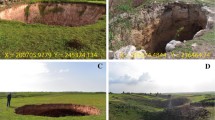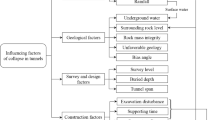The paper presented herein compares and discusses the use of bivariate, multivariate and soft computing techniques for collapse susceptibility modelling. Conditional probability (CP), logistic regression (LR) and artificial neural networks (ANN) models representing the bivariate, multivariate and soft computing techniques were used in GIS based collapse susceptibility mapping in an area from Sivas basin (Turkey). Collapse-related factors, directly or indirectly related to the causes of collapse occurrence, such as distance from faults, slope angle and aspect, topographical elevation, distance from drainage, topographic wetness index (TWI), stream power index (SPI), Normalized Difference Vegetation Index (NDVI) by means of vegetation cover, distance from roads and settlements were used in the collapse susceptibility analyses. In the last stage of the analyses, collapse susceptibility maps were produced from the models, and they were then compared by means of their validations. However, Area Under Curve (AUC) values obtained from all three models showed that the map obtained from soft computing (ANN) model looks like more accurate than the other models, accuracies of all three models can be evaluated relatively similar. The results also showed that the conditional probability is an essential method in preparation of collapse susceptibility map and highly compatible with GIS operating features.














Similar content being viewed by others
References
Bruno E, Calcaterra D and Parise M 2008 Development and morphometry of sinkholes in coastal plains of Apulia, southern Italy. Preliminary sinkhole susceptibility assessment; Eng. Geol. 99 198–209.
Carrara A 1983 Multivariate models for landslide hazard evaluation; Math. Geol. 15(3) 403–426.
Clerici A, Perego S, Tellini C and Vescovi P 2002 A procedure for landslide susceptibility zonation by the conditional analysis method; Geomorphology 48 349–364.
Foody G M, Lucas R M, Curran P J and Honzak M 1996 Estimation of the areal extend of land cover classes that only occur at a sub-pixel level; Canadian J. Rem. Sens. 22 432–438.
Forth R A, Butcher D and Senior R 1999 Hazard mapping of karst along the coast of the Algarve, Portugal; Eng. Geol. 52 67–74.
Galve J P, Bonachea J, Remondo J, Gutiérrez F, Guerrero J, Lucha P, Cendrero A, Gutiérrez M and Sánchez J A 2008 Development and validation of sinkhole susceptibility models in mantled karst settings. A case study from the Ebro valley evaporite karst (NE Spain); Eng. Geol. 99 185–197.
Gokceoglu C, Sonmez H, Nefeslioglu H A, Duman T Y and Can T 2005 The 17 March 2005 Kuzulu landslide-susceptibility map of its near vicinity; Eng. Geol. 81 65–83.
Guerrero J, Gutiérrez F, Bonachea J and Lucha P 2008 A sinkhole susceptibility zonation based on paleokarst analysis along a stretch of the Madrid–Barcelona high-speed railway built over gypsum- and salt-bearing evaporites (NE Spain); Eng. Geol. 102 62–73.
Hall F G, Townshend J R and Engman E T 1995 Status of remote sensing algorithms for estimation of land surface state parameters; Rem. Sens. Environ. 51 138–156.
Hecht-Nielsen R 1987 Kolmogorov’s mapping neural network existence theorem; Proceedings of 1st IEEE International Conference on Neural Networks, San Diego, CA, USA, pp. 11–14.
Karacan E and Yilmaz I 1997 Collapse dolines in the Miocene gypsum: An example from SW Sivas (Turkey); Environ. Geol. 29(3/4) 263–266.
Kaufman O and Quinif Y 2002 Geohazard map of cover-collapse sinkholes in the ‘Tournaisis’ area, southern Belgium; Eng. Geol. 65 117–124.
Kavzoglu T 2001 An investigation of the design and use of feed-forward artificial neural networks in the classification of remotely sensed images; Thesis (PhD), University of Nottingham, School of Geography, 306p.
Klimchouk A and Andrejchuk V 2005 Karst breakdown mechanisms from observations in the gypsum caves of the Western Ukraine: Implications for subsidence hazard assessment; Environ. Geol. 48 336–359.
Lee S and Talib J A 2005 Probabilistic landslide susceptibility and factor effect analysis; Environ. Geol. 47 982–990.
Lee S and TuDan N 2005 Probabilistic landslide susceptibility mapping in the Lai Chau province of Vietnam: Focus on the relationship between tectonic fractures and landslides; Environ. Geol. 48 778–787.
Lee S and Sambath T 2006 Landslide susceptibility mapping in the Damrei Romel area, Cambodia using frequency ratio and logistic regression models; Environ. Geol. 50(6) 847–856.
Menard S 1995 Applied logistic regression analysis; Sage University Paper Series on Quantitative Applications in Social Sciences, 106 Thousand Oaks, California, p. 98.
Nefeslioglu H A, Gokceoglu C and Sonmez H 2008 An assessment on the use of logistic regression and artificial neural networks with different sampling strategies for the preparation of landslide susceptibility maps; Eng. Geol. 97(3–4) 171–191.
Nefeslioglu H A, San B T, Gokceoglu C and Duman T Y 2012 An assessment on the use of Terra ASTER L3A data in landslide susceptibility mapping; Int. J. Appl. Earth Observ. Geoinform. 14 40–60.
Negnevitsky M 2002 Artificial Intelligence – A Guide to Intelligent Systems; Addison – Wesley Co., Great Britain, 394p.
Ramakrishnan D, Ghosh M K, Vinuchandran R and Jeyaram A 2005 Probabilistic techniques, GIS and remote sensing in landslide hazard mitigation: A case study from Sikkim Himalayas, India; Geocarto Int. 20(4) 1–6.
Ramakrishanan D, Singh T N, Purwar N, Badre K S, Gulati A and Gupta S 2008 Artificial neural network and liquefaction susceptibility assessment: A case study using the 2001 Bhuj Earthquake data, Gujarat, India; Comp. Geosci. 12 491–501.
Singh T N, Kanchan R, Verma A K and Singh S 2003 An intelligent approach for prediction of triaxial properties using unconfined uniaxial strength; Mining Eng. J. 5(4) 12–16.
Swets J A 1988 Measuring the accuracy of diagnostic systems; Science 240 1285–1293.
Tolmachev V T, Pidyashenko S E and Balashova T A 1999 The system of antikarst protection on railways of Russia; In: Hydrogeology and Engineering Geology of Sinkholes and Karst (eds) Barry B, Pettit-Arthur J and Herring J G (Rotterdam: A.A. Balkema), pp. 423–429.
Weier J and Herring D 2005 Measuring vegetation (NDVI and EVI). Earth Observatory Library of NASA, http://earthobservatory.nasa.gov/Library/MeasuringVegetation/.
Wilson J P and Gallant J C 2000 Terrain Analysis Principles and Applications; John Wiley and Sons, Inc., Canada.
Yesilnacar E and Topal T 2005 Landslide susceptibility mapping: A comparison of logistic regression and neural networks method in a medium scale study, Hendek region (Turkey); Eng. Geol. 79 251–266.
Yilmaz I 2007 GIS based susceptibility mapping of karst depression in gypsum: A case study from Sivas basin (Turkey); Eng. Geol. 90(1–2) 89–103.
Yilmaz I 2008a Discussion on “Development and morphometry of sinkholes in coastal plains of Apulia, southern Italy. Preliminary sinkhole susceptibility assessment” by E. Bruno, D. Calcaterra, M. Parise [Engineering Geology 99 (2008) 198–209]; Eng. Geol. 101 283–284.
Yilmaz I 2008b A case study for mapping of spatial distribution of free surface heave in alluvial soils (Yalova, Turkey) by using GIS software; Comp. Geosci. 34(8) 993–1004.
Yilmaz I 2009 Landslide susceptibility mapping using frequency ratio, logistic regression, artificial neural networks and their comparison: A case study from Kat landslides (Tokat-Turkey); Comp. Geosci. 35(6) 1125–1138.
Yilmaz I and Karacan E 2005 Slaking durability and its effect on the doline occurrence in the gypsum; Environ. Geol. 47(7) 1010–1016.
Yilmaz I and Yüksek A G 2008 An example of artificial neural network application for indirect estimation of rock parameters; Rock Mech. Rock Eng. 41(5) 781–795.
Yilmaz I and Yüksek A G 2009 Prediction of the strength and elasticity modulus of gypsum using multiple regression, ANN, ANFIS models and their comparison; Int. J. Rock Mech. Mining Sci. 46(4) 803–810.
Zhou W, Beck B F and Adams A 2003 Application of matrix analysis in delineating sinkhole risk areas along highway (I-70 near Frederick, Maryland); Environ. Geol. 44 834–842.
Acknowledgements
The authors are deeply grateful to the anonymous reviewers for their very constructive comments and suggestions which led to the improvement of the quality of the paper. Authors also thank Asst. Dr Hakan A Nefeslioglu (Cumhuriyet University, Sivas – TURKEY) for his useful comments.
Author information
Authors and Affiliations
Corresponding author
Rights and permissions
About this article
Cite this article
YILMAZ, I., MARSCHALKO, M. & BEDNARIK, M. An assessment on the use of bivariate, multivariate and soft computing techniques for collapse susceptibility in GIS environ. J Earth Syst Sci 122, 371–388 (2013). https://doi.org/10.1007/s12040-013-0281-3
Received:
Revised:
Accepted:
Published:
Issue Date:
DOI: https://doi.org/10.1007/s12040-013-0281-3




